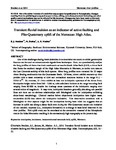Transient fluvial incision as an indicator of active faulting and Plio-Quaternary uplift of the Moroccan High Atlas
| dc.contributor.author | Boulton, SJ | |
| dc.contributor.author | Stokes, M | |
| dc.contributor.author | Mather, AE | |
| dc.date.accessioned | 2015-11-19T17:12:32Z | |
| dc.date.available | 2015-11-19T17:12:32Z | |
| dc.date.issued | 2014-07-03 | |
| dc.identifier.issn | 0040-1951 | |
| dc.identifier.issn | 1879-3266 | |
| dc.identifier.uri | http://hdl.handle.net/10026.1/3826 | |
| dc.description.abstract |
One of the challenges facing Earth Scientists is to determine the extent towhich geomorphic features can be used to extract tectonic signals from landscapes. Here, we quantitatively analyse the long profiles of rivers that drain southwards across the South Atlas Fault (SAF), a thrust fault that forms the southern margin of the High Atlas Mountains in Morocco, to derive new data on the Late Cenozoic activity of this fault system. River long profiles were extracted for 32 major rivers flowing southwards into the Ouarzazate Basin. Of these, eleven exhibit concave-up river profiles with a mean concavity of 0.64 and normalized steepness indices in the range 47.5-219.0 m0.9. By contrast, 21 rivers exhibit at least one knickpoint upstream of the thrust front. Knickpoint height varies from 100 to 1300 m, with calculated incision at the range bounding fault ranging from 80 to 900 m, despite the drainage areas upstream of the knickpoint ranging over several orders of magnitude. In map view, knickpoint locations generally plot along sub-parallel lines and there are no obvious relationships with lithological units for knickpoints exhibiting slope-break morphology. Channel reaches below slope-break knickpoints have higher mean concavities (0.76) than above the knickpoint indicative. This observation combined with a lithological or river-capture origin for the knickpoints having been ruled out suggests that an increase in uplift rate along a planar fault zone during the Plio-Quaternary caused the initiation of the transient response (i.e., knickpoint formation) to a change in base-level observed in the river profiles. This uplift event can be correlated to the convective removal of the lithospheric root to the Atlas Mountains resulting in the anomalously high topography at the present day. | |
| dc.format.extent | 16-33 | |
| dc.language | en | |
| dc.language.iso | en | |
| dc.publisher | Elsevier | |
| dc.subject | Knickpoint | |
| dc.subject | Knickzone | |
| dc.subject | Intracontinental mountain belt | |
| dc.subject | Uplift | |
| dc.subject | Morocco | |
| dc.title | Transient fluvial incision as an indicator of active faulting and Plio-Quaternary uplift of the Moroccan High Atlas | |
| dc.type | journal-article | |
| dc.type | Article | |
| plymouth.author-url | https://www.webofscience.com/api/gateway?GWVersion=2&SrcApp=PARTNER_APP&SrcAuth=LinksAMR&KeyUT=WOS:000345814500002&DestLinkType=FullRecord&DestApp=ALL_WOS&UsrCustomerID=11bb513d99f797142bcfeffcc58ea008 | |
| plymouth.issue | 1 | |
| plymouth.volume | 633 | |
| plymouth.publication-status | Accepted | |
| plymouth.journal | Tectonophysics | |
| dc.identifier.doi | 10.1016/j.tecto.2014.06.032 | |
| plymouth.organisational-group | /Plymouth | |
| plymouth.organisational-group | /Plymouth/Faculty of Science and Engineering | |
| plymouth.organisational-group | /Plymouth/Faculty of Science and Engineering/School of Geography, Earth and Environmental Sciences | |
| plymouth.organisational-group | /Plymouth/REF 2021 Researchers by UoA | |
| plymouth.organisational-group | /Plymouth/REF 2021 Researchers by UoA/UoA07 Earth Systems and Environmental Sciences | |
| plymouth.organisational-group | /Plymouth/REF 2021 Researchers by UoA/UoA14 Geography and Environmental Studies | |
| plymouth.organisational-group | /Plymouth/Research Groups | |
| plymouth.organisational-group | /Plymouth/Research Groups/Marine Institute | |
| plymouth.organisational-group | /Plymouth/Users by role | |
| plymouth.organisational-group | /Plymouth/Users by role/Academics | |
| dc.rights.embargodate | 2015-07-03 | |
| dc.identifier.eissn | 1879-3266 | |
| dc.rights.embargoperiod | 12 months | |
| rioxxterms.versionofrecord | 10.1016/j.tecto.2014.06.032 | |
| rioxxterms.licenseref.uri | http://www.rioxx.net/licenses/under-embargo-all-rights-reserved | |
| rioxxterms.type | Journal Article/Review |


